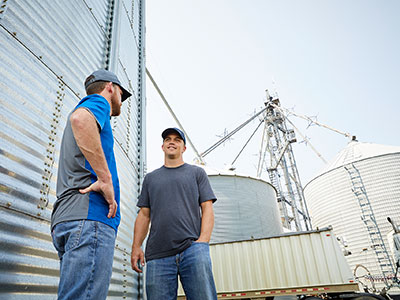Every farm operation is unique. When crop losses occur, adjusters have a variety of factors to consider and calculate when settling a claim.
FMH Field Claims Supervisor Sara Ahrenholz was prepared for a long appointment at a southwest Minnesota farm involving commingled production, splitting by entity, and multiple bin measurements. It was the day after Christmas and she had an adjuster in training with her. When she discovered the policyholders had precision records that met crop insurance requirements, she knew her appointment wouldn’t be as long as she thought.
“I asked the farmer if he could provide records to show that he had calibrated his equipment within three percent to meet RMA requirements,” Ahrenholz said. “He was able to print this record from his SMS farm management software along with the other records I needed for the claim.”
Ahrenholz had planned to sort through the bin measurements that were already taken and start splitting production between the father-son, 1,800-acre operation to verify corn production – easily a couple hours’ worth of paperwork. Instead, she asked for the farmer’s seeding map, harvest wet-weight map, and calibration records…and set the timer on her phone.
 “Seven minutes and four seconds – that’s how long it took me to determine the corn production and verify the loss,” she said. “When I showed the time to the farmer, he just said, ‘huh, that’s incredible!’”
“Seven minutes and four seconds – that’s how long it took me to determine the corn production and verify the loss,” she said. “When I showed the time to the farmer, he just said, ‘huh, that’s incredible!’”
She explained that had these records been provided at the start, it could have saved over 10 hours of work that had been completed, including bin measurements and previous adjusting appointments. The precision records also provided more accurate data which is crucial when working with commingled production.
“If we were not able to show he had commingled grain through these precision records, it would have affected his APH and even indemnity payment,” Ahrenholz noted. While the time Ahrenholz saved is clear, she added that not every Precision Claim has these kinds of results.
“They were just the most ideal candidates I could have found,” she said. “Everything aligned really well, and we only had to focus on corn. While some farmers are already recording what they need for crop insurance, sometimes we only get half of what we need for a Precision Claim, and in those cases, we do help them prepare for a better experience the following year.”
Ahrenholz explained how Precision Claims can not only save time for the farmer, but also for the adjuster. “The farmer doesn’t need to provide the records on site. We can receive the records early and process them ahead of time so when we arrive for the appointment, it’s just reviewing everything with the farmer.”
If a policyholder uses their precision data to report their acreage and production to Farmers Mutual Hail, FMH can use that data to generate the planting and harvest maps an adjuster needs for a Precision Claim. The policyholder would only need to provide calibration records, which can be sent to their adjuster electronically through the FMH Policyholder Center.
Before she wrapped up the appointment, Ahrenholz said she told the farmer what she tells all her farmers: “When you’ve spent all this time making sure your data is right, why not use that for a claim?”


